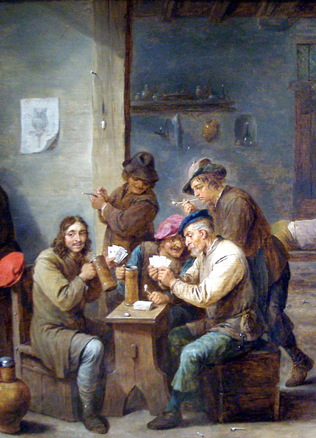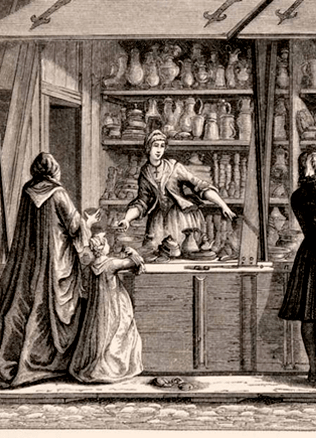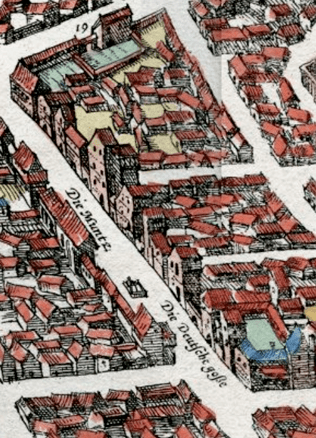Plunder – a kind of business
Lithuanians appeared on the arena of history as a nation of warriors. Predatory marches that started at the end of the 12th century continued throughout the entire 13th and the 14th centuries. At first activity of Lithuanian soldiery was concentrated near the Dauguva River, and in the first decades of the 13th century the Lithuanian soldiery was located along the upper reaches of the Lovat and Dnieper Rivers. It was not by accident that these regions were chosen: the most significant trade routes ran along these rivers. The major incentive for the marches was plunder. The low level of faming, absence of towns, poorly developed trade and infrastructure in Lithuania could not satisfy the appetite for riches, prestige, force and power the Lithuanian nobility bore. Therefore, the easiest and fastest way of becoming rich was chosen. German tribes behaved in a similar way during the Migration Period, while the Scandinavian Vikings did the same few centuries later. The Mongols began with the plunder and revenge marches of local significance and ended up creating a great empire. The hight of their activity coincided with that of the Lithuanians.
A fast way of becoming rich
Predatory marches did not only have military but also social and economic aspects.
Predatory marches enabled the warriors to stay alive and become richer at the expense of their more distant neighbours.
Lithuania’s seclusion from the important trade objectives, absence of centres of strong political power in the neighbourhood in the 10th – 11th century prevented the states of Poland and Rus’ that were newly forming at that time to include Lithuanian lands in their political economic orbit. The same seclusion of Lithuania did not allow effective punitive measures against the Lithuanian lands to be implemented. This political situation determined that the Lithuanians forayed the lands of the Ruthenians much more often than the latter forayed the Lithuanian lands. This balance of power enabled the Lithuanians to move over to territorial expansion in the middle of the 13th century and introduce more civilised forms of exploiting the lands of Rus’. Speaking about the lands of Rus’, which were not subject to the Lithuanian authorities but opposed to them, predatory marches posed danger to the neighbours until Lithuania’s expansion stopped in the period following the death of Vytautas.
The most horrible nightmare of the Latgalians
The first to experience the terror of the Lithuanian predatory marchers were the neighbouring tribes of Semigallians, Selians, Latigalians, Livians, and Estonians.
The Latgalians seem to have suffered from the Lithuanian forays most. This is what the chronicler Henry of Latvia says: “At that time the Lithuanians outdid all the tribes that lived in these lands, both those which adopted Christianity and those which remained pagan. Few of them had courage to live in their villages, the Latigalians in particular. The latter, having abandoned their homes, always looked for shelter in the thicket of the forests, but even in this way they failed to escape from the Lithuanians because the latter, who constantly set traps for the Latigalians caught them in forests, killed some of them, took prisoners the others and seized all their property”. The archaeological finds show that at that time the quantitative ratio between the horned cattle and pigs changed considerably in the territory of Latvia: cows, oxen and sheep became almost extinct, and pigs became most common animals. This change can be explained by the fact that pigs are impossible to drive back.
Some natives living under constant threat had frightful visions. One Livian explained why the locals were afraid to meet him in the following way: “I saw the Livian God who foretold me my future. That was the shape stretched upwards the middle of a tree that said to me that the following day the Lithuanian army would come marching”. The priest understood that this forecast could not be true because “at that time in autumn there was no road along which the Lithuanians could march”. Images remind one of the darkest intergenic relations on the African and South American continents.
New neighbours – new plunder
Do You Know?
At the end of the 12th – the 14th century all the neighbours suffered from the predatory marches of the Lithuanians, however, the Letigalian tribes were ravaged most severely. The archaeological finds show that at that time the quantitative ratio between horned cattle and pigs changed considerably on the present-day territory of Latvia: cows, oxen and sheep became almost extinct, and pigs became common. This change can be accounted for by the fact that pigs are impossible to drive back.
It was not only people who used to fall victim to the predatory marches, but it could also be a more valuable thing. For example, the Lithuanians who marched to the lands of the Lattigallians in 1201 had to turn back immediately because they received the news that the Duke of Polotsk had invaded their lands. Though they were in a hurry they did not miss the opportunity to rob the fishermen of the Bishop of Riga of their clothes.
After the Germans had settled in Livonia and built the first churches there, the latter became an object of interest to the Lithuanians.
By the way, the first sound of the Lithuanian language was recorded by the chronicler Henry of Latvia during one of such visits. In 1207, when the Lithuanians were ravaging the village of Kubesele on Christmas Eve, the local priests did not interrupt the mass though their parishioners had run away. After the mass had come to an end and all expensive things had been hidden in the vestry, one Lithuanian entered the Church but seeing that there was nothing on the altar what he wanted to take uttered only one sound: “Ba!”, and rushed elsewhere to look for booty.
Activity of the Lithuanians in plundering the lands of their neighbours in the 13th century shows that this kind of activity was important. It was this activity that enabled the nobility to amass a necessary amount of property within a short time, which would guarantee them prestige and authority. Political power is impossible without property. This allowed the nobility to acquire political influence and concentrate power in their hands. The histories of Lithuania and the neighbouring countries (e.g. Poland and Rus’) show that the creation of the state is related to the establishment of monarchical government in a concrete territory. It was only then that the possibilities to develop more civilised relations with the neighbours opened up, and the new tasks were set to the rulers: they did not have only to concern themselves with the defence of their country but also had to administer justice, take care of the protection of foreigners, additional sources of income from trade, customs and the like.
Darius Baronas



